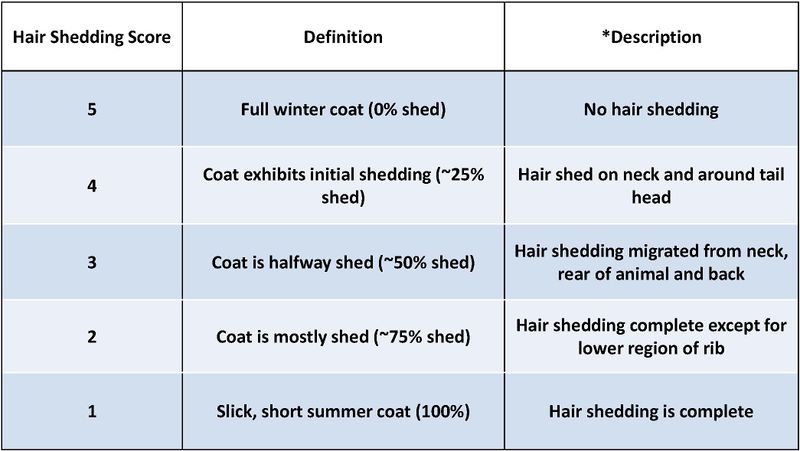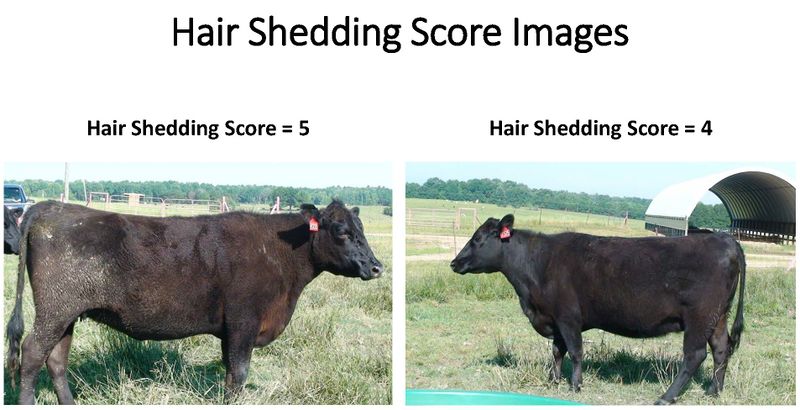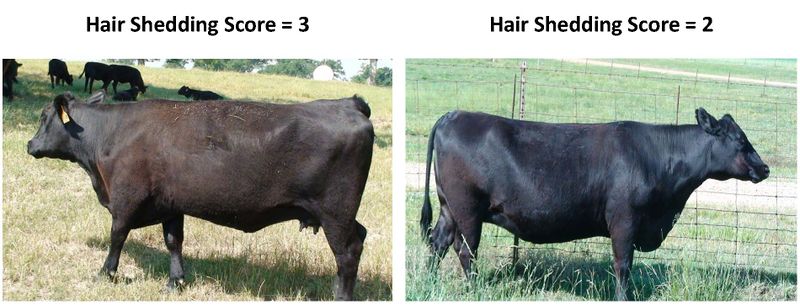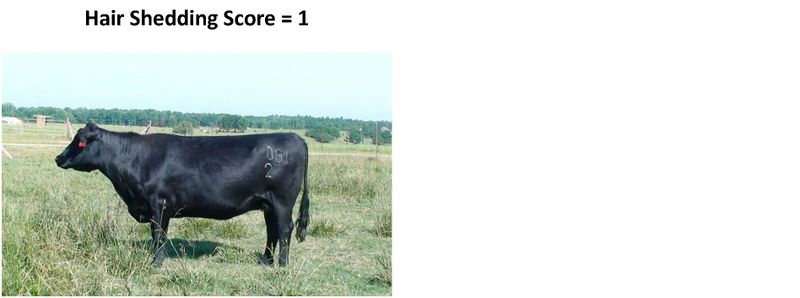Difference between revisions of "Hair Shedding"
Trentsmith (talk | contribs) |
|||
| (11 intermediate revisions by 3 users not shown) | |||
| Line 1: | Line 1: | ||
| − | + | [[Category:Management/Convenience Traits]] | |
| − | |||
Hair shedding measures the approximate amount of winter hair coat that is lost from the whole body during the spring and summer months. Hair shedding does not indicate hair length or type. | Hair shedding measures the approximate amount of winter hair coat that is lost from the whole body during the spring and summer months. Hair shedding does not indicate hair length or type. | ||
| − | + | ===Phenotype=== | |
Hair shedding scores can be taken monthly from March to July. In most regions of the U.S. it is recommended that the herd be evaluated during the month of May. This time period seems to correlate when most cattle have initiated the process of shedding and when most variation occurs within the herd. This could vary in different regions of the U.S. | Hair shedding scores can be taken monthly from March to July. In most regions of the U.S. it is recommended that the herd be evaluated during the month of May. This time period seems to correlate when most cattle have initiated the process of shedding and when most variation occurs within the herd. This could vary in different regions of the U.S. | ||
| Line 13: | Line 12: | ||
'''Description of hair coat shedding scores''' | '''Description of hair coat shedding scores''' | ||
---- | ---- | ||
| − | + | <center> | |
| − | + | [[File: Wiki Hair Shedding Score Table.jpg|800px]] | |
| − | + | </center> | |
| + | ''*Description is based on typical hair shedding patterns in cattle.'' | ||
| + | ---- | ||
| + | <center> | ||
| + | [[File: Wiki Hair Shedding Score Images 5 and 4.jpg|800px]] | ||
| + | </center> | ||
| + | ---- | ||
| + | <center> | ||
| + | [[File: Wiki Hair Shedding Score Images 3 and 2.jpg|800px]] | ||
| + | </center> | ||
| + | ---- | ||
| + | <center> | ||
| + | [[File: Wiki Hair Shedding Score Image 1.jpg|800px]] | ||
| + | </center> | ||
| + | ---- | ||
| + | ===Contemporary Group=== | ||
| − | + | It is recommended that the whole herd be scored in a single day to maximize the size of contemporary groups. | |
| − | + | ===Genetic Evaluation=== | |
| − | |||
| − | + | Data collected should be reported to the respective breed association for possible use in genetic evaluations. Angus Genetics International has implemented a Hair Shedding EPD<ref>Durbin, H.J., D. Lu, H. Yampara-Iquise, S. P. Miller and J. E. Decker. 2020. Development of a genetic evaluation for hair shedding in American Angus cattle to improve thermotolerance. Genetics Selection Evolution, 52(1), pp.1-14.</ref> | |
| − | |||
| − | + | ===Usage=== | |
| − | |||
| − | |||
| − | + | Producers can use hair coat shedding scores as a culling tool to reduce heat stress in their herds. Hair coat shedding is known to be moderately heritable and repeatable from year to year. Cattle that have a shedding score of 4 to 5 in May should be considered for culling in the southeastern U.S. Hair shedding scores on cows have been shown to have a negative relationship with the weaning weights of their calves. Females that shed earlier during the year tend to wean heavier calves than their counterparts.<ref>Gray, K. A., T. Smith, C. Maltecca, P. Overton, J. A. Parish, and J. P. Cassady. 2011. Differences in hair coat shedding, and effects on calf weaning weight and BCS among Angus dams. Livestock Science 140.1: 68-71.</ref> | |
| − | + | ===References=== | |
Latest revision as of 23:45, 12 December 2022
Hair shedding measures the approximate amount of winter hair coat that is lost from the whole body during the spring and summer months. Hair shedding does not indicate hair length or type.
Phenotype
Hair shedding scores can be taken monthly from March to July. In most regions of the U.S. it is recommended that the herd be evaluated during the month of May. This time period seems to correlate when most cattle have initiated the process of shedding and when most variation occurs within the herd. This could vary in different regions of the U.S.
Hair shedding scores are based on a 1 to 5 scale with a score of 1 being completely shed or having a slick appearance and a score of 5 having not shed or having a rough hair coat appearance over the entire body. Percentage shedding is relative to the approximate amount of winter hair loss in relation to the body size of the individual.
Hair shedding scores can be taken on both sexes and animals of all ages. It is recommended to take scores at yearling during their first spring. The following table lists the scores, definition, and descriptions.
Description of hair coat shedding scores
*Description is based on typical hair shedding patterns in cattle.
Contemporary Group
It is recommended that the whole herd be scored in a single day to maximize the size of contemporary groups.
Genetic Evaluation
Data collected should be reported to the respective breed association for possible use in genetic evaluations. Angus Genetics International has implemented a Hair Shedding EPD[1]
Usage
Producers can use hair coat shedding scores as a culling tool to reduce heat stress in their herds. Hair coat shedding is known to be moderately heritable and repeatable from year to year. Cattle that have a shedding score of 4 to 5 in May should be considered for culling in the southeastern U.S. Hair shedding scores on cows have been shown to have a negative relationship with the weaning weights of their calves. Females that shed earlier during the year tend to wean heavier calves than their counterparts.[2]
References
- ↑ Durbin, H.J., D. Lu, H. Yampara-Iquise, S. P. Miller and J. E. Decker. 2020. Development of a genetic evaluation for hair shedding in American Angus cattle to improve thermotolerance. Genetics Selection Evolution, 52(1), pp.1-14.
- ↑ Gray, K. A., T. Smith, C. Maltecca, P. Overton, J. A. Parish, and J. P. Cassady. 2011. Differences in hair coat shedding, and effects on calf weaning weight and BCS among Angus dams. Livestock Science 140.1: 68-71.



